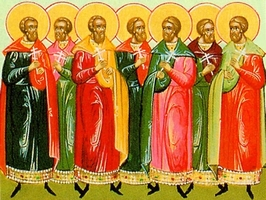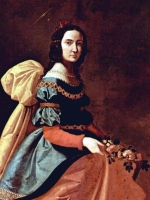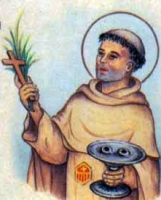Blessed Pedro María Ramírez Ramos
Profile
The son of Ramón Ramírez Flórez and Isabel Ramos, he was baptized at the age of one day. Feeling a call to the priesthood, Pedro began his studies on 4 October 1915 in the diocese of Garzón, Colombia, but in 1920 he began to have doubts about his vocation, and left the seminary. For the next few years he lived as a single man, worked as a choir director in several places, suffered from severe headaches, and never stopping his discernment of a vocation. By 1928, with the help of a pious female friend, Pedro decided that he was, indeed, called to the priesthood, and returned to his studies. Ordained a priest on 21 June 1930.
Parish priest in the Chaparral region, then in Cunday, Colombia in 1934, in El Fresno, Colombia in 1943, and then in Armero, Colombia in 1948. When the the Colombian civil war, known as La Violencia, broke out, his parishioners tried to smuggle him out of the area – the Socialist Colombian Liberal Party blamed Father Pedro for the killing of their leader, which triggered the conflict. Pedro refused to leave, saying that his parishioners would need him during the conflict. On the afternoon of 10 April 1948, some members of the Colombian Liberal Party broke into his church, found Father Pedro putting the finishing touches on his will, accused him of a number of offenses, dragged him to the town square, and murdered him. Martyr.
Born
23 October 1899 in La Plata, Huila, Colombia
Died
• hanged and beaten with a machete at about 4:00pm on 10 April 1948 in the town square of Armero, Tolima, Colombia
• his body was mutilated, left to hang for a while as a warning to others, then thrown in a ditch near the local cemetery
• on 21 April 1948, government officials took the remains to perform an autopsy
• in May 1948, Pedro's parents were able to get the body released to them
• buried in the family cemetery plot in La Plata, Huila, Colombia
Beatified
• 8 September 2017 by Pope Francis
• the beatification recognition was celebrated at the Parque Temático Las Malocas, Villavicencio, Meta, Colombia with Pope Francis as chief celebrant
Saint Fulbert of Chartres
தூய ஃபுல்பர்ட் ( ஏப்ரல் 10)
இயேசு ஞானத்திலும் உடல்வளர்ச்சியிலும் மிகுந்து கடவுளுக்கும் மனிதருக்கும் உகந்தவராய் வாழ்ந்து வந்தார்.
வாழ்க்கை வரலாறு
ஃபுல்பர்ட், பிரான்ஸ் நாட்டில் உள்ள பிகார்டி என்னும் இடத்தில் பிறந்தார். இவர் எந்த ஆண்டு பிறந்தார், இவருடைய குழந்தைப் பருவம் எப்படி இருந்தது என்பது போன்ற தகவல்கள் சரியாகக் கிடைக்கவில்லை.
தன்னுடைய தொடக்ககால கல்வியை ஃபுல்பர்ட், ஹெர்பர்ட் என்பவரிடம் கற்றார். இந்த ஹெர்பர்ட்தான் பின்னாளில் திருத்தந்தை இரண்டாம் சில்வெஸ்டராக உயர்ந்தார். படிக்கும்போதே திறமையானவராக விளங்கிய ஃபுல்பர்ட் வளர்ந்து, பெரியவரான பிறகு மிகச் சிறந்த கல்வியாளராக மாறினார். எந்தளவுக்கு என்றால், அவரிடம் பாடம் கற்ற மாணவர்கள் அனைவரும் அவரை அன்போடு ‘வணக்கத்திற்குரிய சாக்ரடீஸ்’ என்றே அழைத்து வந்தார்கள்.
ஃபுல்பர்ட்டிடம் இருந்த திறமையைப் பார்த்துவிட்டு ஆயர் பேரவை இவரை சார்ட்ரஸ் என்ற இடத்திற்கு ஆயராக உயர்த்தினார்கள். ஆயராக உயர்ந்தபின்பு ஃபுல்பர்ட் மிகச் சிறப்பான பணிகளைச் செய்து வந்தார். குறிப்பாக திருச்சபையின் சொத்துகளை ஒருசில பொதுநிலையினர் நன்றாக அனுபவித்து வாழ்ந்தபோது, அதனைக் கடுமையாக விமர்சித்தார். அது மட்டுமல்லாமல், தவறு செய்த ஒருசில குருக்களையும் ஏன் ஒருசில ஆயர்களைக் கடுமையாக விமர்சித்தார். இதனால் அவருக்கு கடுமையான எதிர்ப்புகள் கிளம்பின. ஃபுல்பர்ட் அதைக் கண்டு பயப்படாமல், துணிவோடு உண்மையை எடுத்துரைத்தார். இவ்வாறு அவர் ஆண்டவருக்குச் சான்று பகர்ந்தார்.
ஃபுல்பர்ட் மிகச் சிறந்த கவிஞராகவும் விளங்கினார். அதனால் அவர் மரியாவைக் குறித்து அதிகமான கவிதைகளைப் புனைந்தார். இவரைக் குறித்து இன்னொன்றை நாம் சொல்லியாக வேண்டும். அதுதான் மரியன்னையின் பிறப்பு விழாவை முதன்முறையாகக் கொண்டாடியது இவரே ஆகும். இப்படி பல்வேறு பணிகளைச் செய்து வந்த ஃபுல்பர்ட் 1029 ஆம் ஆண்டு, ஏப்ரல் 10 ஆம் நாள் இறையடி சேர்ந்தார். இவருடைய உடல் சாட்ரஸ் பேராலயத்தில் அடக்கம் செய்யப்பட்டது.
Also known as
Fulbertus of Chartres
Profile
Grew up around Rome, Italy, and known as a promising student. Studied the Benedictine abbey in Rheims, France. A favourite student of the future Pope Sylvester II, he was brought to Rome as an advisor to Sylvester. Upon the pope's death, Fulbert returned to France where he served as canon and chancellor of the diocese of Chartres, and ran the cathedral school there, which became known as a leading center of learning in France. Bishop of Chartres in 1007. Advisor to French clergy and secular leaders, including the king of France. Noted preacher and travelling bishop who went from parish to parish ensuring there was proper Christian education of his flock. Re-built the Chartres cathedral after it burned. Wrote a number of poems and hymns, many of them about the Virgin Mary, to whom he was greatly devoted. Fought simony, assigning ecclesiastical benefices to laymen, opposed bishops who acted as generals. Friend of Saint Odilo of Cluny.
Born
c.960 in Italy
Died
10 April 1029 in Chartres, France of natural causes
Representation
• preaching monk
• in his sick bed with the Virgin Mary nearby
Blessed Antoine Neyrot
Also known as
Anthony Neyrot
Profile
Joined the Dominicans at the convent of San Marco in Florence, Italy as a young man. While travelling to preach in Naples, Italy, he was captured by Moorish pirates, he was taken to Tunis, Tunisia. He was initially treated pretty well, but his captors perceived him as arrogant for being sure of his faith and imprisoned him and gave him only bread and water. To escape, he renounced Christianity, began to study Islam, worked on a translation of the Koran, and even married. However, he apparently never completely lost his faith, was overcome with remorse, and after a few months he resumed his Dominican habit, found a priest, came back to the Church and publicly proclaimed himself a Christian. Martyr.
Born
c.1425 at Rivoli, diocese of Turin, Italy
Died
• stoned to death on 10 April 1460 in Tunis, Tunisia
• body returned to Rivoli, Italy by merchants travelling through the region
Beatified
22 February 1767 by Pope Clement XIII (cultus confirmation)
Blessed Boniface Zukowski
Also known as
• Bonifacy Zukowski
• Piotr Zukowski
• prisoner #25447
Additional Memorial
12 June as one of the 108 Martyrs of World War II
Profile
Son of Andrzej Zukowski and Albina Walkiewicz and raised on a farm. Entered the Order of Friars Minor Conventual in Niepokalanów in Teresin, Poland at age 16, taking the name Bonifacy and making his solemn profession on 2 August 1935. Worked at the house's printing presses, publishing The Knight of the Immaculate, helping in the work of Saint Maximilian Kolbe. Priest. Arrested by the Gestapo on 14 October 1941 for his publishing work and for trying to protect the printing presses, and imprisoned in Warsaw, Poland. He spent his time there ministering to other prisoners. Shipped to the Dachau concentration camp, he was put to forced labour in bad weather, beaten for lack of work, and finally died from the mistreatment. Martyr.
Born
13 January 1913 in Rapa-Baran, Nemencine, Vilniaus rajonas, Lithuania as Piotr Zukowski
Died
10 April 1942 of pneumonia in the camp infirmary of Dachau, Oberbayern, Germany
Beatified
13 June 1999 by Pope John Paul II in Warsaw, Poland
Saint Miguel de Sanctis
புனித_மைக்கேல்_தெ_சேங்டிஸ் (1591-1625)
ஏப்ரல் 10
இவர் (#StMichaelDeSantis) ஸ்பெயின் நாட்டைச் சார்ந்தவர். தனது பெற்றோரின் முன்மாதிரியான வாழ்க்கையை பார்த்து வளர்ந்த இவர், 6 வயதிலேயே துறவியாக வேண்டும் என்று எண்ணம் கொண்டார்.
இந்நிலையில் இவரது பெற்றோர் இறந்து விட, இவர் ஒரு வணிகரிடம் பணியாளராகச் சேர்ந்து வேலை செய்து வந்தார்.
இவருக்குப் பன்னிரண்டு வயது நடக்கும்போது பார்சிலோனாவில் இருந்த ஒரு துறவு மடத்தில் சேர்ந்து துறவியானார்; பதினைந்தாவது வயதில் இறுதி வார்த்தைபாட்டை எடுத்துக் கொண்டார்.
இறைவேண்டலுக்கும் ஒறுத்தல் முயற்சிகளுக்கும் மிகுந்த முக்கியத்துவம் கொடுத்து வந்த இவர், 1607 ஆம் ஆண்டு மேட்ரிட் என்ற இடத்திலிருந்த வேறொரு துறவுமடத்தில் போய்ச் சேர்ந்தார். பின்னர் செவிலி என்ற இடத்திற்குச் சென்று, கல்வி கற்று, குருவாக அருள்பொழிவு செய்யப்பட்டார்.
இதன்பிறகு இவர் நற்கருணை ஆண்டவர் முன்பாக மிகுதியான நேரத்தை செலவழித்தார்; திருப்பலி நிறைவேற்றும்போது மெய்ம்மறந்து நின்றார்.
இப்படி நற்கருணை ஆண்டவர்மீது மிகுதியான பற்றுக்கொண்டு வாழ்ந்த இவர், 1625 ஆம் ஆண்டு இறையடி சேர்ந்தார். இவருக்குத் திருத்தந்தை ஒன்பதாம் பயஸ் 1862 ஆம் ஆண்டு புனிதர் பட்டம் கொடுத்தார்.
Also known as
• Michael de Sanctis
• Michael of the Saints
• Michael the Ecstatic
Profile
Michael decided at age six that he wanted to be a monk, and imposed such austerities on himself as a child that he had to be restrained. Orphaned, he became the apprentice of a merchant. Tried to join the Trinitarian monastery in Barcelona, Spain at age 12. Took his vows at age 15 at the monastery of Saint Lambert at Zaragoza, Spain on 5 September 1607. Later felt drawn to the more austere Discalced Trinitarians; began his novitiate at Madrid, Spain, studied in Seville, Spain and Salamanca, Spain, and took vows at Alcalá, Spain. Priest. Twice elected superior of the monastery at Valladolid, Spain. Lived a life of prayer and great mortification; especially devoted to the Holy Eucharist, and is said to have been rapt in ecstasy several times during Consecration. He was considered by his brothers to be a saint in life.
Born
29 September 1591 at Vich, Catalonia, Spain
Died
10 April 1625 at Valladolid, Spain of natural causes
Canonized
8 June 1862 by Pope Pius IX
Blessed Mark Fantucci
Also known as
• Marcus Fantuzzi
• Marco Fantucci
• Marcus of Bologna
• Pace, Pasotto
Profile
Born wealthy and known as an excellent student. Lawyer. In his mid-20's he felt a call to religious life and gave up his career to enter the Franciscan in 1430, taking the name Marcus. Priests. Guardian of the monastery of Monte Colombo. Noted preacher in Italy, Istria, and Dalmatia. Provincial and then Vicar General of the Franciscans. A reformer who worked to take the Order back to the spirituality and observance of their roots. Worked with Saint Catherine of Bologna to set up a Poor Clare monastery in Bologna, Italy. When Pope Paul II said he wanted to elevate Marcus to Cardinal, he fled to Sicily to avoid it. Helped to set up the Monti di Pietà, charitable pawn shops to help the poor escape greedy money lenders. Helped defeat the plan of Pope Sixtus IV to unite all branches of the Franciscans.
Born
c.1405 at Bologna, Italy as Pace or Pasotto
Died
10 April 1479 at Piacenza, Italy of natural causes
Beatified
5 March 1868 by Pope Pius IX (cultus confirmed)
Saint Maddalena of Canossa
புனிதர் மகதலின் கனொஸ்ஸா
அருட்கன்னி மற்றும் சபை நிறுவனர்:
ஏற்கும் சமயம்:
ரோமன் கத்தோலிக்க திருச்சபை
பிறப்பு: மார்ச் 2, 1774
வெரோனா, வெனிஸ் குடியரசு
இறப்பு: ஏப்ரல் 10, 1835
வெரோனா, லொம்பார்டி-வெனிஷியா அரசு, ஆஸ்திரிய பேரரசு
முக்திபேறு பட்டம்: டிசம்பர் 7, 1941
திருத்தந்தை 12ம் பயஸ்
புனிதர் பட்டம்: அக்டோபர் 2, 1988
திருத்தந்தை 2ம் ஜான் பால்
நினைவுத் திருநாள்: ஏப்ரல் 10
புனிதர் மகதலின் கனொஸ்ஸா ஒரு இத்தாலிய அருட்சகோதரியும், சபை நிறுவனரும் ஆவார். இவர் தமது பிராந்தியத்திலுள்ள ஏழை மக்களின் வழக்குரைஞராக பணியாற்றியவர் ஆவார்.
வெனிஸ் குடியரசிலுள்ள வெரோனா (Verona) எனும் இடத்தில் பிறந்த இவரது தந்தை பெயர் “மார்க்கிஸ் ஒக்டோவியோ டி கனோஸ்ஸா” (Marquis Ottavio di Canossa) ஆகும். இவரது தாயார் பெயர் “தெரேசா ஸ்லூஹா” (Teresa Szluha) ஆகும். இவர் பிறந்த மறுதினமே திருமுழுக்கு பெற்றார்.
மகதலின் ஐந்து வயதாக இருக்கும்போது அவரின் தந்தை ஒரு விபத்தில் இறந்துவிட்டார். இரண்டு வருடங்களின் பிறகு, இவரது தாய் மறுமணம் செய்துகொள்வதற்காக தமது ஐந்து குழந்தைகளையும் விட்டு பிரிந்து 'மான்ட்டுவா' (Mantua) எனும் இடத்திற்கு சென்றார். இதன் காரணமாக, குழந்தைகள் அனைவரும் அவர்களது மாமனது பாதுகாப்பில் வளர்ந்தனர்.
தாழ்ச்சியிலும், பக்தியிலும் சிறந்து விளங்கிய மகதலின் குழந்தையாக இருந்த போதே துறவியாக வேண்டுமென்று ஆசைப்பட்டார். 1791ம் ஆண்டு, மகதலின் தன் ஊரிலிருந்த கார்மேல் மடத்திற்கு சென்று அவ்வப்போது ஜெபித்து வந்தார். கார்மேல் மடத்திற்கு சென்று தஞ்சம் அடைந்தார். அங்கு மகதலின் கார்மேல் மட கன்னியர்களால் வளர்க்கப்பட்டார். மகதலின் கார்மேல் துறவியர் இல்லத்தில் தமது நேரத்தை செலவிட ஆரம்பித்தார்.
பள்ளிப்படிப்பை முடித்தபின், தம் பதினைந்தாம் வயதில் கார்மேல் மடத்தில் துறவற பயிற்சியில் சேர்ந்தார். எட்டு மாதங்கள் கழித்து, தன் சொந்த ஊரிலிருந்து, ட்ரேவிசோ (Treviso) என்ற ஊரிலிருந்த கார்மேல் மடத்திற்கு பயிற்சிக்காக அனுப்பிவைக்கப்பட்டார். ஆனால் அங்கிருந்து சில மாதங்களிலிலேயே விரைவில் வெரொனா திரும்பினார். பின்னர், தமது குடும்ப சொத்தான பெரும் தோட்டங்களை நிர்வகிக்க தொடங்கினார்.
வெரோனாவில் உள்ள ஏழைகள் மகதலின் கவனத்தை ஈர்த்தனர். அவர்கள் ஃபிரெஞ்ச் புரட்சி இராணுவ படையெடுப்பால் பாதிக்கப்பட்டிருந்தனர். இந்நிலை, மகதலினாவை அவர்களுக்காக சேவை செய்யும் மனதை தந்தது.
கி.பி. 1808ம் ஆண்டு, கைவிடப்பட்ட குழந்தைகளை தொடர்ந்து பராமரிக்க வேண்டி, உதவிக்காக ஜெனோவா மாவட்டத்திலிருந்த ஓர் அதிகாரியிடம் பேச்சுவார்த்தை நடத்தினார். இதன் பயனாக 1808ம் ஆண்டு, “கருணையின் மகள்கள்”, "ஏழைகளின் சேவகர்கள்" (Congregation of the Daughters of Charity, Servants of the Poor) என்ற சபையை நிறுவினார்.
பிறகு கி.பி. 1810 மற்றும் கி.பி. 1812ம் ஆண்டுகளில் வெனிஸ் நகரிலிருந்த தெருக் குழந்தைகளுக்கு, வெனிஸில் 2 சபையையும், கி.பி. 1816ம் ஆண்டு மிலானிலுள்ள பெர்கமோவிலும் (Bergamo) சபைகளை நிறுவினார்.
கி.பி. 1828ம் ஆண்டு திருத்தந்தை பன்னிரெண்டாம் லியோ அவர்களால், இச்சபை திருத்தந்தையின் அதிகாரத்திற்குட்பட்ட சபையாக அங்கீகரிக்கப்பட்டது. அதன்பிறகு இச்சபை இத்தாலி, இந்தியா, இந்தோனிசியா, ஆப்பிரிக்கா, தென் அமெரிக்கா என பல நாடுகளில் பரவியது.
மகதலின் கி.பி. 1835ம் ஆண்டு, ஏப்ரல் 10ம் நாள் வெரோனாவில் மரித்தார்.
கி.பி. 1941ம் ஆண்டு, திருத்தந்தை 12ம் பயஸ் அவர்களால் முக்திபேறு பட்டம் கொடுக்கப்பட்டது.
திருத்தந்தை 2ம் ஜான் பால் அவர்களால், கி.பி. 1988ம் ஆண்டு, அக்டோபர் மாதம் இரண்டாம் நாள், புனிதராக அருட்பொழிவு செய்விக்கப்பட்டார்.
Also known as
• Magdalena Gabriela Canossa
• Magdalen Canossa
Additional Memorial
8 May (Canossians)
Profile
One of five children born to a wealthy and famous family, her father died and mother abandoned them all to a governess when Maddalen was five years old. Nun, studying in the Carmel of Trent, Italy and then Conegliano, Italy. Developed a ministery to the poor in Verona, Italy based in the Canossa Castle of her family. Founder of the Canossian Daughters of Charity and the Canossian Sons of Charity with a mission of providing free education to poor children. By the end of the 20th century there were more than 2,600 Canossians working around the world.
Born
1 March 1774 in Verona, Italy
Died
10 April 1835 in Verona, Italy of natural causes
Canonized
2 October 1988 by Pope John Paul II
Saint Macarius of Antioch
Also known as
• Macarius of Ghent
• Macarius of Armenia
• Macaire, Macario
Profile
Bishop of Antioch, Pisidia. Archbishop of Constantinople. Captured by Saracens, but escaped. He then resigned his see to become a pilgrim through Palestine, Epirus, Dalmatia, Bavaria, and other western areas, finally settling with the Benedictine monks of Saint Bavo Abbey in Ghent, Belgium. Miracle worker.
Born
at Antioch, Pisidia
Died
1012 at monastery of Saint Bavo, Ghent, Belgium of the plague
Patronage
• against plague
• Andorra
• Ghent, Belgium
Representation
• bishop with three arrowheads
• with his mitre and crozier on the ground to symbolize his resignation of the bishopric
Saint Bademus
Also known as
Bademo, Vadim
Profile
Born to the wealthy Persian nobility, Bademus cared little for worldly things, and when he was old enough he founded and led a monastery in Bethlapeta, Persia. He and seven of his monks were imprisoned for their faith during the lengthy persecution by King Sapor. Chained and regularly beaten for four months, he was murdered by Nersan, an apostate Persian prince who hacked him to death to prove his renunciation of Christianity.
Died
• clumsily beheaded 10 April 376
• body thrown to the dogs but recovered and secretly buried by Christians
Blessed Paternus the Scot
Also known as
• Paternus Scotus
• Paternus of Abdinghof
• Paternus of Paderborn
• Padarn...
Profile
Hermit. Monk. Joined a group of brothers who emigrated to Westphalia (in modern Germany, and was one of the first monks at Abdinghof Abbey under the leadership of Blessed Meinwerk of Paderborn. Much admired by Saint Peter Damian and Blessed Marianus Scotus.
Born
Ireland or Scotland (the term "the Scot" was used to refer to both places at that time)
Died
burned to death when the Abdinghof Abbey, Westphalia, Germany caught fire in 1058
Saint Bede the Younger
Also known as
Beda
Profile
Courtier to King Charles the Bald of France. After 40 years of service, he gave up the worldly life to become a monk at the monastery of Gavello, Italy. He declined to become a bishop, citing his inadequacy.
Died
• 10 April 883
• buried in the monastery graveyard in Gavello, Italy
• relics translated to church of San Benigno monastery, Genoa, Italy in 1233 as the original monastery had declined
Blessed Eberwin of Helfenstein
Profile
Augustinian canon. In 1121 he and several companions took over the abandoned Benedictine monastery of Springiersbach in Steinfeld, Germany. In 1130 they joined the Premonstratensians, and Eberwin served as provost. Fought heretical teaching throughout the region. Friend of Saint Bernard of Clairvaux.
Died
10 April 1152 in Steinfeld, Germany
Blessed Antonio Vallesio
Profile
Mercedarian missionary to Tunisia. Arrested by Muslim authorities for preaching Christianity, sentenced to forced labour, but simply dragged outside of town and murdered. Martyr.
Born
Liguria, Italy
Died
stoned to death in 1293 outside Tunis, Tunisia
Blessed Marco Mattia
Profile
Joined the Mercedarians at the convent at Maleville, France. Missionary to Tunisia in 1293. Grabbed by a Muslim mob and murdered for preaching Christianity. Martyr.
Born
near Toulouse, France
Died
hacked to pieces on a hill outside Tunis, Tunisia in 1293
Saint Malchus of Waterford
Profile
Benedictine monk at Winchester, England. First bishop of Waterford, Ireland consecrated by Saint Anselm of Canterbury in 1096. Preceptor of Saint Malachy O'More.
Born
Ireland
Saint Ethor of Chertsey
Also known as
Hethor
Profile
Benedictine monk and priest at Chertsey Abbey. Martyred with 90 of his brothers by pagan Danish raiders.
Died
martyred in 869 at Chertsey, England
Saint Hedda of Peterborough
Profile
Benedictine abbot of Peterborough Abbey. Martyred with many of his brother monks by pagan Danish raiders.
Died
martyred in 869 at Peterborough, England
Saint Palladius of Auxerre
Also known as
Palladium
Profile
Abbot of Saint Germanus in Auxerre, France. Bishop of Auxerre; founded several monasteries.
Died
661
Saint Apollonius of Alexandria
Profile
Priest in Alexandria, Egypt. Martyred with five companions in the persecutions of Decius.
Died
c.250 in Alexandria, Egypt
Saint Beocca of Chertsey
Profile
Benedictine abbot at Chertsey Abbey. Martyred with 90 of his brothers by pagan Danish raiders.
Died
869 at Chertsey, England
Saint Gajan
Profile
Fourth century deacon. Martyr.
Died
martyred in Dacia (an area of modern Romania)
Martyrs of Carthage
Profile
A group of 50 Christians who were imprisoned in a pen of snakes and scorpions, and then martyred, all during the persecutions of Decius. Only six of their names have come down to us - Africanus, Alessandro, Massimo, Pompeius, Terence and Teodoro.
Died
beheaded in 250 at Carthage
Martyrs of Georgia
Profile
Approximately 6,000 Christian monks and lay people martyred in Georgia in 1616 for their faith by a Muslim army led by Shah Abbas I of Persia.
Martyrs of Ostia
Profile
A group of criminals who were brought to the faith by Pope Saint Alexander I while he was in prison with them. Martyrs.
Died
drowned by being taken off shore from Ostia, Italy, in a boat which was then scuttled, c.115


























